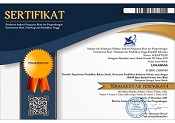TRADISI BABARIT SEBAGAI MODEL BAHAN AJAR KEARIFAN LOKAL DI SMA (Kajian Semiotik dan Etnopedagogik)
Abstract
Tujuan penelitian ini mendeskripsikan unsur semiotik, nilai etnopedagogik, dan penerapan hasil penelitian tradisi Babarit pada model ajar kearifan lokal di SMA. Metode yang digunakan dalam penelitian ini adalah etnografi, dengan teknik telaah pustaka, observasi partisipan, wawancara, dan dokumentasi. Instrumen penelitian ini adalah pedoman observasi, pedoman wawancara, handphone, kamera digital, dan data profil Desa Cikupa. Hasil dari penelitian ini adalah sebagai berikut. Pertama, unsur semiotika Roland Barthes meliputi tanda, hubungan simbolik-paradigmatik-sintagmatik, bahasa-wicara dan budaya, dan signifikasi terdapat pada unsur-unsur asal-mula, pelaku, barang-barang, makanan, dan proses pelaksanaan tradisi Babarit. Kedua, nilai pendidikan karakter yang terdapat pada unsur-unsur tradisi Babarit ada 15 yaitu nilai religius, nilai jujur, nilai toleransi, nilai disiplin, nilai kerja keras, nilai kreatif, nilai mandiri, nilai demokratis, nilai rasa ingin tahu, nilai semangat kebangsaan, nilai cinta tanah air, nilai bersahabat/komunikatif, nilai peduli lingkungan, nilai peduli sosial, dan nilai tanggung jawab. Ketiga, hasil kajian semiotik dan etnopedagogik dalam tradisi Babarit dijadikan salah satu alternatif model bahan ajar kearifan lokal pada materi bahasan budaya Sunda di SMA. Selain itu, nilai-nilai yang terdapat dalam tradisi ini bisa dijadikan sebagai pedoman dalam kehidupan beragama dan bermasyarakat.
Abstract
The purpose of this study was to describe the semiotic elements, ethno-pedagogic values, and the research results from implementation on the local wisdom teaching model in senior high school. The method used in this research was ethnography, with literature review techniques, participant observation, interviews, and documentation. The instruments of this study were observation guidelines, interview guidelines, cell-phones, digital cameras, and Cikupa Village profile data. The results of this study are as follows: First, Roland Barthes's semiotic element includes signs, symbolic-paradigmatic-syntagmatic, speech-language and cultural relations, and significance is found in the elements of origin, actors, goods, food, and the process of implementing Babarit tradition. Second, the value of character education found in the elements of the Babarit tradition is 15 i.e. religious values, honest values, tolerance values, disciplinary values, hard work values, creative values, independent values, democratic values, curiosity values, national spirit values, the value of love the homeland, the value of being friendly/communicative, the value of environment care, the value social care, and the value of responsibility. Third, the results of the study of semiotic and ethnopedagogic in the Babarit tradition were used as an alternative model of local wisdom discussion teaching material in Sundanese culture in senior high school. In addition, the values contained in this tradition can also be used as guidelines in religious and community life.
Keywords
Full Text:
PDFReferences
Agatha, A. (2016). “Traditional Wisdom in Land Use and Resource Management Among the Lugbara of Uganda: A Historical Perspective” (vol. 6, 22 Agustus 2016).
Alwasilah, Chaedar spk. (2009). Etnopedagogi. Bandung: PT Kiblat Buku Utama.
Baal, J.V. (diterjemahkan oleh J Piry). (1987). Sejarah dan Pertumbuhan Teori Antropologi Budaya (Hingga Dekade 1970). Jakarta: Gramedia.
Chusorn, P., A. Wallapha, & C. Prayuth. (2014). “Strategy Challenges the Local Wisdom Applications Sustainability in Schools” (vol. 112, pages 626-634). Thailand: Elsevier B.V.
Danadibrata, R.A. (2006). Kamus Basa Sunda. Bandung: Kiblat Buku Utama.
Dieker. L, dkk. (2009). “Evaluating Video Models of Evidence-Based Instructional Practices to Enhance Teacher Learning”. University of Central Florida, University of Florida, University of South Florida, University of North Carolina–Charlotte, University of Florida, James Madison University, University of Louisville Teacher Education and Special Education (vol. 32 number 2, 180-196, 7 April 2009).
Digdoyo, E. (2015). Ilmu Sosial dan Budaya Dasar. Bogor: Ghalia Indonesia.
Emzir. (2012). Metodologi Penelitian Pendidikan Kualitatif dan Kuantitatif. Jakarta: Rajagrafindo Persada.
Isnendes, R. (2010). Kajian Sastra Aplikasi Teori dan Kritik pada Karya Sastra Sunda dan Indonesia. Bandung: Daluang Publishing.
Isnendes, R. (2013). “Struktur dan Fungsi Upacara Ngalaksa di Kecamatan Rancakalong Kabupaten Sumedang dalam Perspektif Pendidikan Karakter”. (Disertasi). Pendidikan Bahasa Indonesia SPs, UPI, Bandung.
Kilstrup, M. 2015. Naturalizing Semiotics : The triadic sign of Charles Sanders Peirce as A Systems Property (1-13). Denmark.
Ljungberg, M & Greckhamer, T. (2005). “Strategic Turns Labeled ‘Ethnography’:From Description To Openly Ideological Production Of Cultures”. University Of Florida Louisiana State University (vol. 5 (3): 285-306, 1 Agustus 2005).
LBSS. (2007). Kamus Umum Basa Sunda. Bandung: Geger Sunten.
Mushaf Marwah. (2009). Al-Quran, Terjemah dan Tafsir untuk Wanita. Bandung: Jabal.
Suratman, Munir, & Salamah, U. (2013). Ilmu Sosial dan Budaya Dasar. Malang: Intimedia.
DOI: https://doi.org/10.17509/jlb.v9i1.15674
Refbacks
- There are currently no refbacks.
Copyright (c) 2019 LOKABASA

This work is licensed under Creative Commons Attribution-ShareAlike 4.0 International License.










